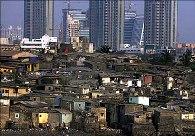 | « Back to article | Print this article |
7 ways to improve infrastructure in Indian cities
 The challenge for India is to write a new chapter in low-cost urban development, the way it has done in wireless telephony and automobiles, says Subir Roy.
The challenge for India is to write a new chapter in low-cost urban development, the way it has done in wireless telephony and automobiles, says Subir Roy.
Most of the additional 250 million Indians who will look for an urban habitat in the next 20 years will do so in existing towns and cities whose healthy and orderly growth will define the quality of Indian urban life.
McKinsey & Co has estimated that this will cost a colossal $1.2 trillion in capital expenditure alone (about India's current GDP).
Booz & Co has estimated that the government will have to spend $1 trillion in capital expenditure, not in 20 but 10 years! Plus a sharp improvement will be needed in urban governance.
While the latter is not negotiable, the former is, and the challenge for India is to write a new chapter in low-cost urban development, the way it has done in wireless telephony and automobiles (Nano).
Conventional urban solutions put in place so far are high-cost - metro rail, elevated expressways, flyovers and bringing drinking water to cities over large distances - and also ineffective. Traffic congestion keeps getting worse, water remains scarce and slums, despite some redevelopment, keep growing.
The first pillar on which low-cost urban development can be built is to look not at the top cities but the bottom ones.
The hierarchy of cities in terms of size - from metros at the top to say tier III cities at the bottom - also holds in terms of costs. McKinsey estimates that Mumbai will need more than twice the per capita investment than Patna will in the next 20 years. So, strengthen smaller cities first. Precisely the opposite is being done today with enormous Central government help for metro rail in cities like Delhi, Mumbai, Bangalore and Chennai.
Linked to this is the second pillar - make mass bus transit, not metro rail transit (the latter costs ten times more), the cornerstone of the solution to traffic and transportation, the number one problem afflicting Indian cities today.
With an efficient public transport system, the need for cars will go down, reducing the pressure on roads and need for flyovers, etc.
More and more Indian cities over time will have to get their drinking water from faraway places via costly water transportation systems (pipelines plus pumping stations), something in which Bangalore is the unfortunate leader today.
So, the third pillar is an affordable water solution based on extensive rainwater harvesting and recycling of waste water.
The fourth pillar is a different solid-waste disposal system. The compostable part of it has to be turned into energy and the rest incinerated to the extent possible. This will truncate the huge problem of locating adequate dumping grounds for waste.
The solution has to begin with waste segregation at the household level. Commercially successful, simple, off-the-shelf solutions are available for households to use their biodegradable waste to make compost at home.
So, tomorrow's affordable city will be relatively small, where the roads will be full of buses, bicycles and walkers and relatively fewer cars, with every building having a rainwater harvesting system, most with solar power panels on the roof and streets made bright with LED lighting.
Its leitmotif will be a Ginger hotel, not a Taj or Oberoi property. Booz outlines a range of "intelligent" IT-enabled, cost-effective solutions across sectors for Indian cities which are city-size neutral. But the big plus of a small city is that it is softer - less built up - and, therefore, cheaper to rebuild. It is cheaper to widen a road or build a bus terminus in a small city than a big one because land prices are lower in the former.
Incremental urban growth implies notifying over time more and more peripheral areas of existing urban bodies for inclusion in them. Currently, as a city spills over into a non-urban area beyond its limits and gets built up (de facto urbanised), its boundary is extended to include the new reality.
Solution (fifth pillar): keep notifying swathes of non-urban land beyond a city before these get built up, that is while they are still soft, so that there can be some planned development. This is cheaper than trying to reshape a hard area.
The sixth pillar is for city planners, in both mega and smaller cities, to promote as much of mixed-use development as possible. Incentivise developments which have both office and residential spaces, so that some of those who work in the new offices can live next door and not have to make long commutes. This is easier done in urban peripheral areas and smaller cities as developing residential space in large cities and central business districts is prohibitively costly.
The seventh pillar and perhaps the most critical is promoting low-cost housing within cities. This is easier said than done. The first step is to redo inner city slums (install sewerage, sanitation, water supply, etc.) and then build living units of maybe 300 sq ft carpet area which those with records of residence there can own by paying the construction cost through housing loans.
EMIs will be paid with what was paid earlier as rent. Success will hinge on keeping builders out and getting contractors to deliver to specifications on a cost-plus basis.
The new owners will sell off and go to newer slums? No matter, develop them too. Public expenditure will be manageable as slums are usually on public land or owned by slumlords who hold either fake titles or none at all.
The key is to trigger development with little public investment and city dwellers, there for jobs, largely paying for their electricity, health care, education and the like.
